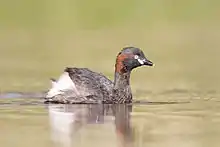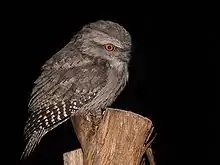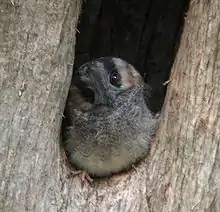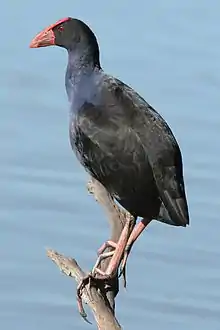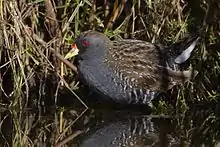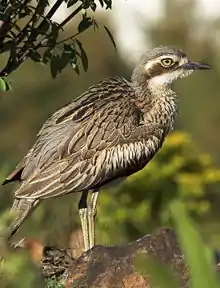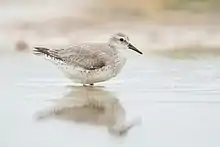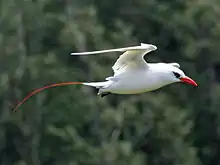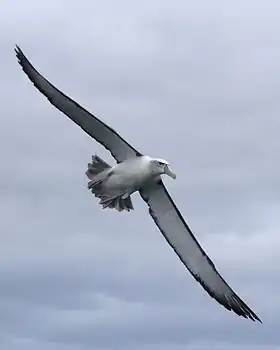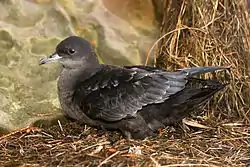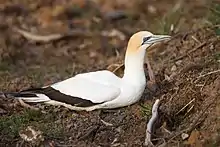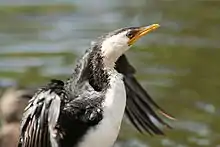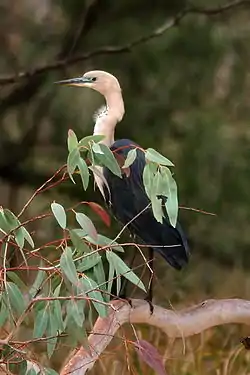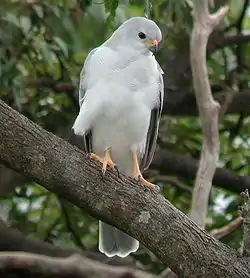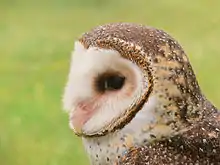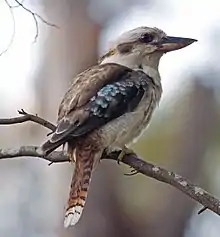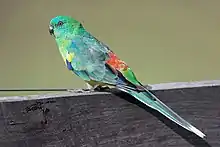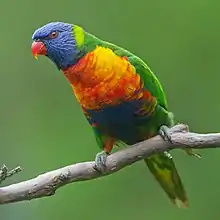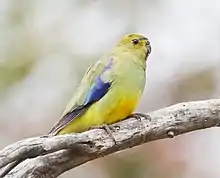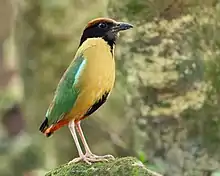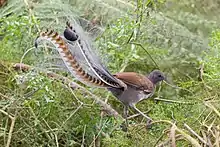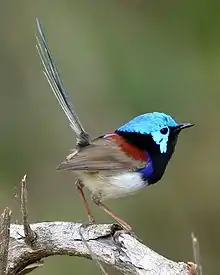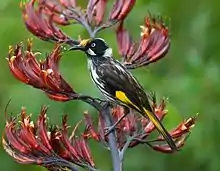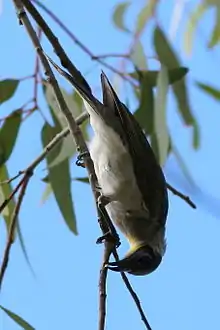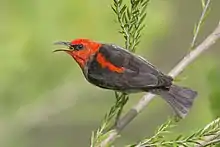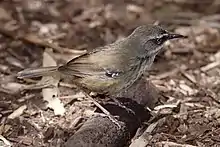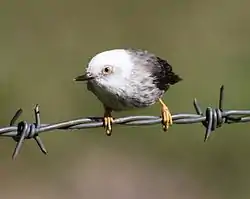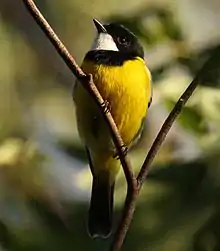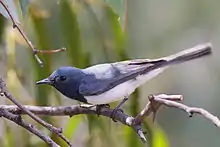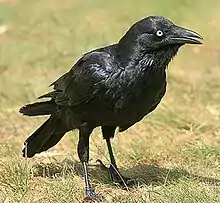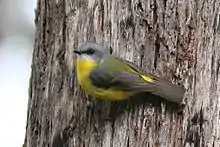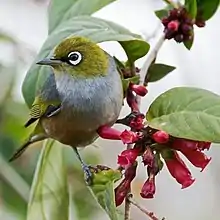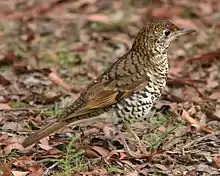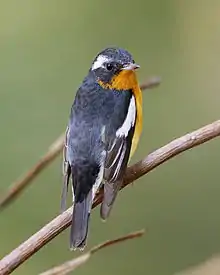List of birds of Australia
This is a list of the wild birds found in Australia including its outlying islands and territories, but excluding the Australian Antarctic Territory. The outlying islands covered include: Christmas, Cocos (Keeling), Ashmore, Torres Strait, Coral Sea, Lord Howe, Norfolk, Macquarie and Heard/McDonald. The list includes introduced species, common vagrants and recently extinct species. It excludes species only present in captivity. 957 extant and extinct species are listed.

1. Cocos (Keeling) Islands
2. Christmas Island
3. Ashmore Reef
4. Torres Strait Islands
5. Lord Howe Island
6. Norfolk Island
7. Macquarie Island
8. Heard Island and McDonald Islands
| Part of a series on |
| Wildlife of Australia |
|---|
 |
There have been three comprehensive accounts: the first was John Goulds Birds of Australia, the second Gregory Mathews, and third was the Handbook of Australian, New Zealand and Antarctic Birds (1990-2006).
The taxonomy originally followed is from Christidis and Boles, 2008.[1] Their system has been developed over nearly two decades[2] and has strong local support,[3] but deviates in important ways from more generally accepted schemes. Supplemental updates follow The Clements Checklist of Birds of the World, 2019 edition.
[4][5] This list also uses British English throughout. Any bird names or other wording follows that convention.
Ostriches
Order: Struthioniformes Family: Struthionidae
1 species recorded [1 introduced]
This order is not native to Australia, but feral populations of one species have become established in South Australia and possibly on the New South Wales/Victoria border.
| Common name | Binomial | Notes |
|---|---|---|
| Common ostrich | Struthio camelus | introduced |
Cassowaries and emu
Order: Casuariiformes Family: Casuariidae
2 species recorded [2 extant native]
This family of flightless ratite birds is represented by two living species in Australia. Another two species are found in New Guinea. The extinct, geographically-isolated King and Kangaroo Island emus were historically considered to be separate species to mainland emus. However, genetic evidence from 2011 suggests that all three are conspecific.
| Common name | Binomial | Notes |
|---|---|---|
| Southern cassowary | Casuarius casuarius | |
| Emu | Dromaius novaehollandiae |
Magpie goose
Order: Anseriformes Family: Anseranatidae
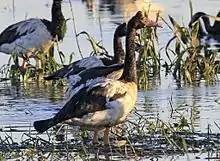
1 species recorded [1 extant native]
The family contains a single species, the magpie goose. It was an early and distinctive offshoot of the anseriform family tree, diverging after the screamers and before all other ducks, geese and swans, sometime in the late Cretaceous. The single species is found across Australia.
| Common name | Binomial | Notes |
|---|---|---|
| Magpie goose | Anseranas semipalmata |
Ducks, geese, and waterfowl
Order: Anseriformes Family: Anatidae
29 species recorded [20 extant native, 2 introduced, 7 vagrant]
The family Anatidae includes the ducks and most duck-like waterfowl, such as geese and swans. These are adapted for an aquatic existence, with webbed feet, bills that are flattened to a greater or lesser extent, and feathers that are excellent at shedding water due to special oils. In Australia, 29 species have been recorded, of which two have been introduced, and seven are vagrants.
| Common name | Binomial | Notes |
|---|---|---|
| Spotted whistling-duck | Dendrocygna guttata | |
| Plumed whistling-duck | Dendrocygna eytoni | |
| Wandering whistling-duck | Dendrocygna arcuata | |
| Canada goose | Branta canadensis | vagrant, presumably from introduced NZ population |
| Cape Barren goose | Cereopsis novaehollandiae | |
| Freckled duck | Stictonetta naevosa | |
| Mute swan | Cygnus olor | introduced |
| Black swan | Cygnus atratus | |
| Radjah shelduck | Radjah radjah | |
| Australian shelduck | Tadorna tadornoides | |
| Paradise shelduck | Tadorna variegata | vagrant, Lord Howe Island & NSW |
| Green pygmy-goose | Nettapus pulchellus | |
| Cotton pygmy-goose | Nettapus coromandelianus | |
| Australian wood duck | Chenonetta jubata | |
| Garganey | Spatula querquedula | |
| Australian shoveler | Spatula rhynchotis | |
| Northern shoveler | Spatula clypeata | vagrant |
| Eurasian wigeon | Mareca penelope | vagrant |
| Pacific black duck | Anas superciliosa | |
| Northern mallard | Anas platyrhynchos | introduced |
| Northern pintail | Anas acuta | vagrant |
| Green-winged teal | Anas crecca | vagrant, Cocos (Keeling) Island |
| Grey teal | Anas gracilis | |
| Chestnut teal | Anas castanea | |
| Pink-eared duck | Malacorhynchus membranaceus | |
| Hardhead | Aythya australis | |
| Tufted duck | Aythya fuligula | vagrant |
| Blue-billed duck | Oxyura australis | |
| Musk duck | Biziura lobata |
Megapodes
Order: Galliformes Family: Megapodiidae
3 species recorded [3 extant native]
Megapodiidae are represented by various species in the Australasian region, although only three species are found in Australia. They are commonly referred to as "mound-builders" due to their habit of constructing large mounds to incubate their eggs.
| Common name | Binomial | Notes |
|---|---|---|
| Australian brushturkey | Alectura lathami | |
| Malleefowl | Leipoa ocellata | |
| Orange-footed scrubfowl | Megapodius reinwardt |
Guineafowl
Order: Galliformes Family: Numididae
1 species recorded [1 introduced]
Numididae are not native to Australia, but feral populations of one species exist in Queensland.
| Common name | Binomial | Notes |
|---|---|---|
| Helmeted guineafowl | Numida meleagris | introduced |
New World quail
Order: Galliformes Family: Odontophoridae
1 species recorded [1 introduced]
Odontophoridae are not native to Australia, but feral populations of one species survive in external territories and possibly the mainland.
| Common name | Binomial | Notes |
|---|---|---|
| California quail | Callipepla californica | introduced, Norfolk & King Island |
Pheasants, grouse, and allies
Order: Galliformes Family: Phasianidae
8 species recorded [3 extant native, 5 introduced]
Phasianidae consists of the pheasants and their allies. These are terrestrial species, variable in size but generally plump, with broad, relatively short wings. Many species are gamebirds or have been domesticated as a food source for humans. Three species are native to Australia, and five commonly domesticated species are feral, with most established populations persisting on offshore islands.
| Common name | Binomial | Notes |
|---|---|---|
| Indian peafowl | Pavo cristatus | introduced, King, Rottnest & Furneaux Islands |
| Brown quail | Coturnix ypsilophora | |
| Blue-breasted quail | Excalfactoria chinensis | |
| Stubble quail | Coturnix pectoralis | |
| Red junglefowl | Gallus gallus | introduced, Norfolk & Christmas Island |
| Green junglefowl | Gallus varius | introduced, Cocos (Keeling) Islands |
| Ring-necked pheasant | Phasianus colchicus | introduced, King, Flinders & Rottnest Island |
| Wild turkey | Meleagris gallopavo | introduced, King, Flinders & Kangaroo Island |
Flamingos
Order: Phoenicopteriformes Family: Phoenicopteridae
1 species recorded [1 vagrant]
Australia has only a single record of any flamingo species, from the North Keeling Island. Several prehistoric species are also known to have existed.
| Common name | Binomial | Notes |
|---|---|---|
| Greater flamingo | Phoenicopterus roseus | vagrant, Cocos (Keeling) Islands |
Grebes
Order: Podicipediformes Family: Podicipedidae
4 species recorded [3 extant native, 1 vagrant]
Grebes are small to medium-large freshwater diving birds. They have lobed toes and are excellent swimmers and divers. However, they have their feet placed far back on the body, making them quite ungainly on land. Three species have been regularly recorded in Australia, and a fourth is a vagrant.
| Common name | Binomial | Notes |
|---|---|---|
| Little grebe | Tachybaptus ruficollis | vagrant |
| Australasian grebe | Tachybaptus novaehollandiae | |
| Hoary-headed grebe | Poliocephalus poliocephalus | |
| Great crested grebe | Podiceps cristatus |
Pigeons and doves
Order: Columbiformes Family: Columbidae
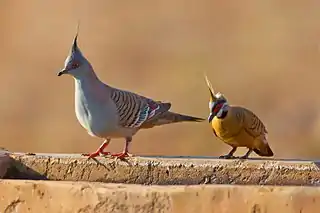
40 species recorded [27 extant native, 3 introduced, 7 vagrant, 2 extirpated native, 1 extinct native]
Pigeons and doves are stout-bodied birds with short necks and short slender bills with a fleshy cere. In Australian territory 40 species have been recorded, three of which have been introduced, and another six are vagrants. One has become extinct since European colonisation.

Bustards
Order: Otidiformes Family: Otididae
1 species recorded [1 extant native]
Bustards are large terrestrial birds mainly associated with dry open country and steppes in the Old World. They are omnivorous and nest on the ground. They walk steadily on strong legs and big toes, pecking for food as they go. They have long broad wings with "fingered" wingtips and striking patterns in flight. Many have interesting mating displays.
| Common name | Binomial | Notes |
|---|---|---|
| Australian bustard | Ardeotis australis |
Cuckoos
Order: Cuculiformes Family: Cuculidae
21 species recorded [14 extant native, 7 vagrant]
The family Cuculidae includes cuckoos, roadrunners and anis. These birds are of variable size with slender bodies, long tails and strong legs. The Old World cuckoos are brood parasites.
Frogmouths
Order: Caprimulgiformes Family: Podargidae
3 species recorded [3 extant native]
The frogmouths are a distinctive group of small nocturnal birds related to swifts found from India across southern Asia to Australia. Three species are found in Australia.
| Common name | Binomial | Notes |
|---|---|---|
| Tawny frogmouth | Podargus strigoides | |
| Marbled frogmouth | Podargus ocellatus | |
| Papuan frogmouth | Podargus papuensis |
Nightjars and allies
Order: Caprimulgiformes Family: Caprimulgidae
5 species recorded [3 extant native, 2 vagrant]
Nightjars are medium-sized nocturnal birds that usually nest on the ground. They have long wings, short legs and very short bills. Most have small feet, of little use for walking, and long pointed wings. Their soft plumage is camouflaged to resemble bark or leaves.
| Common name | Binomial | Notes |
|---|---|---|
| Spotted nightjar | Eurostopodus argus | |
| White-throated nightjar | Eurostopodus mystacalis | |
| Grey nightjar | Caprimulgus jotaka | vagrant, Ashmore Reef |
| Large-tailed nightjar | Caprimulgus macrurus | |
| Savanna nightjar | Caprimulgus affinis | vagrant, Christmas Island |
Owlet-nightjars
Order: Caprimulgiformes Family: Aegothelidae
1 species recorded [1 extant native]
The owlet-nightjars are a distinctive group of small nocturnal birds related to swifts found from the Maluku Islands and New Guinea to Australia and New Caledonia. One species is found in Australia.
| Common name | Binomial | Notes |
|---|---|---|
| Australian owlet-nightjar | Aegotheles cristatus |
Swifts
Order: Caprimulgiformes Family: Apodidae
9 species recorded [4 extant native, 5 vagrant]
Swifts are small birds which spend the majority of their lives flying. These birds have very short legs and never settle voluntarily on the ground, perching instead only on vertical surfaces. Many swifts have long swept-back wings which resemble a crescent or boomerang. Nine species recorded in Australian territory, five of which are vagrants.
| Common name | Binomial | Notes |
|---|---|---|
| Papuan spine-tailed swift | Mearnsia novaeguineae | vagrant, Torres Strait |
| White-throated needletail | Hirundapus caudacutus | |
| Christmas Island swiftlet | Collocalia natalis | Christmas Island |
| Glossy swiftlet | Collocalia esculenta | vagrant |
| Australian swiftlet | Aerodramus terraereginae | |
| Uniform swiftlet | Aerodramus vanikorensis | vagrant |
| Mossy-nest swiftlet | Aerodramus salangana | vagrant |
| Pacific swift | Apus pacificus | |
| House swift | Apus affinis | vagrant |
Rails, gallinules, and coots
Order: Gruiformes Family: Rallidae
24 species recorded [15 extant native, 7 vagrant, 1 extirpated, 1 extinct native]
Rallidae is a large family of small to medium-sized birds which includes the rails, crakes, coots and gallinules. Typically they inhabit dense vegetation in damp environments near lakes, swamps or rivers. In general they are shy and secretive birds, making them difficult to observe. Most species have strong legs and long toes which are well adapted to soft uneven surfaces. They tend to have short, rounded wings and to be weak fliers.
Cranes
Order: Gruiformes Family: Gruidae
2 species recorded [2 extant native]
Cranes are large, long-legged and long-necked birds. Unlike the similar-looking but unrelated herons, cranes fly with necks outstretched, not pulled back. Most have elaborate and noisy courting displays or "dances".
| Common name | Binomial | Notes |
|---|---|---|
| Sarus crane | Antigone antigone | |
| Brolga | Antigone rubicunda |
Sheathbills
Order: Charadriiformes Family: Chionidae
1 species recorded [1 extant native]
The sheathbills are scavengers of the Antarctic regions. They have white plumage and look plump and dove-like but are believed to be similar to the ancestors of the modern gulls and terns.
| Common name | Binomial | Notes |
|---|---|---|
| Black-faced sheathbill | Chionis minor | Heard Island; mainland vagrant |
Thick-knees
Order: Charadriiformes Family: Burhinidae
2 species recorded [2 extant native]
The thick-knees are a group of largely tropical waders in the family Burhinidae. They are found worldwide within the tropical zone, with some species also breeding in temperate Europe and Australia. They are medium to large waders with strong black or yellow-black bills, large yellow eyes and cryptic plumage. Despite being classed as waders, most species have a preference for arid or semi-arid habitats.
| Common name | Binomial | Notes |
|---|---|---|
| Bush thick-knee | Burhinus grallarius | |
| Beach thick-knee | Esacus magnirostris |
Stilts and avocets
Order: Charadriiformes Family: Recurvirostridae

3 species recorded [3 extant native]
Recurvirostridae is a family of large wading birds, which includes the avocets and stilts. The avocets have long legs and long up-curved bills. The stilts have extremely long legs and long, thin straight bills.
| Common name | Binomial | Notes |
|---|---|---|
| Pied stilt | Himantopus leucocephalus | |
| Banded stilt | Cladorhynchus leucocephalus | |
| Red-necked avocet | Recurvirostra novaehollandiae |
Oystercatchers
Order: Charadriiformes Family: Haematopodidae
3 species recorded [2 extant native, 1 vagrant]
The oystercatchers are large and noisy plover-like birds, with strong bills used for smashing or prising open molluscs.
| Common name | Binomial | Notes |
|---|---|---|
| Pied oystercatcher | Haematopus longirostris | |
| South Island oystercatcher | Haematopus finschi | vagrant |
| Sooty oystercatcher | Haematopus fuliginosus |
Plovers and lapwings
Order: Charadriiformes Family: Charadriidae

21 species recorded [15 extant native, 6 vagrant]
The family Charadriidae includes the plovers, dotterels and lapwings. They are small to medium-sized birds with compact bodies, short, thick necks and long, usually pointed, wings. They are found in open country worldwide, mostly in habitats near water.
| Common name | Binomial | Notes |
|---|---|---|
| Black-bellied plover | Pluvialis squatarola | |
| European golden-plover | Pluvialis apricaria | |
| American golden-plover | Pluvialis dominica | vagrant |
| Pacific golden-plover | Pluvialis fulva | |
| Grey-headed lapwing | Vanellus cinereus | vagrant |
| Banded lapwing | Vanellus tricolor | |
| Masked lapwing | Vanellus miles | |
| Lesser sand-plover | Charadrius mongolus | |
| Greater sand-plover | Charadrius leschenaultii | |
| Caspian plover | Charadrius asiaticus | vagrant |
| Double-banded plover | Charadrius bicinctus | |
| Red-capped plover | Charadrius ruficapillus | |
| Kentish plover | Charadrius alexandrinus | vagrant |
| Common ringed plover | Charadrius hiaticula | vagrant |
| Semipalmated plover | Charadrius semipalmatus | vagrant |
| Little ringed plover | Charadrius dubius | |
| Oriental plover | Charadrius veredus | |
| Red-kneed dotterel | Erythrogonys cinctus | |
| Hooded plover | Thinornis cucullatus | |
| Black-fronted dotterel | Elseyornis melanops | |
| Inland dotterel | Peltohyas australis |
Plains-wanderer
Order: Charadriiformes Family: Pedionomidae
1 species recorded [1 extant native]
The plains-wanderer is a quail-like ground bird. They are excellent camouflagers, and will first hide at any disturbance. If they're approached too close, they will run as opposed to flying, which they are very poor at.
| Common name | Binomial | Notes |
|---|---|---|
| Plains-wanderer | Pedionomus torquatus |
Painted-snipe
Order: Charadriiformes Family: Rostratulidae
1 species recorded [1 extant native]
Painted-snipe are short-legged, long-billed birds similar in shape to the true snipes, but more brightly coloured.
| Common name | Binomial | Notes |
|---|---|---|
| Australian painted-snipe | Rostratula australis |
Jacanas
Order: Charadriiformes Family: Jacanidae
2 species recorded [1 extant native, 1 vagrant]
The jacanas are a group of waders found throughout the tropics. They are identifiable by their huge feet and claws which enable them to walk on floating vegetation in the shallow lakes that are their preferred habitat.
| Common name | Binomial | Notes |
|---|---|---|
| Comb-crested jacana | Irediparra gallinacea | |
| Pheasant-tailed jacana | Hydrophasianus chirurgus | vagrant |
Sandpipers and allies
Order: Charadriiformes Family: Scolopacidae
47 species recorded [29 extant native, 18 vagrant]
Scolopacidae is a large diverse family of small to medium-sized shorebirds including the sandpipers, curlews, godwits, shanks, tattlers, woodcocks, snipes, dowitchers, and phalaropes. The majority of these species eat small invertebrates picked out of the mud or soil. Variation in length of legs and bills enables multiple species to feed in the same habitat, particularly on the coast, without direct competition for food.
| Common name | Binomial | Notes |
|---|---|---|
| Upland sandpiper | Bartramia longicauda | vagrant |
| Whimbrel | Numenius phaeopus | |
| Little curlew | Numenius minutus | |
| Far Eastern curlew | Numenius madagascariensis | |
| Eurasian curlew | Numenius arquata | vagrant |
| Bar-tailed godwit | Limosa lapponica | |
| Black-tailed godwit | Limosa limosa | |
| Hudsonian godwit | Limosa haemastica | vagrant |
| Ruddy turnstone | Arenaria interpres | |
| Great knot | Calidris tenuirostris | |
| Red knot | Calidris canutus | |
| Ruff | Calidris pugnax | |
| Broad-billed sandpiper | Calidris falcinellus | |
| Sharp-tailed sandpiper | Calidris acuminata | |
| Stilt sandpiper | Calidris himantopus | vagrant |
| Curlew sandpiper | Calidris ferruginea | |
| Temminck's stint | Calidris temminckii | vagrant |
| Long-toed stint | Calidris subminuta | |
| Red-necked stint | Calidris ruficollis | |
| Sanderling | Calidris alba | |
| Dunlin | Calidris alpina | vagrant |
| Baird's sandpiper | Calidris bairdii | vagrant |
| Little stint | Calidris minuta | vagrant |
| White-rumped sandpiper | Calidris fuscicollis | vagrant |
| Buff-breasted sandpiper | Calidris subruficollis | vagrant |
| Pectoral sandpiper | Calidris melanotos | |
| Asian dowitcher | Limnodromus semipalmatus | |
| Short-billed dowitcher | Limnodromus griseus | vagrant |
| Long-billed dowitcher | Limnodromus scolopaceus | vagrant |
| Latham's snipe | Gallinago hardwickii | |
| Pin-tailed snipe | Gallinago stenura | |
| Swinhoe's snipe | Gallinago megala | |
| Terek sandpiper | Xenus cinereus | |
| Wilson's phalarope | Phalaropus tricolor | vagrant |
| Red-necked phalarope | Phalaropus lobatus | |
| Red phalarope | Phalaropus fulicarius | vagrant |
| Common sandpiper | Actitis hypoleucos | |
| Green sandpiper | Tringa ochropus | vagrant |
| Grey-tailed tattler | Tringa brevipes | |
| Wandering tattler | Tringa incana | |
| Spotted redshank | Tringa erythropus | vagrant |
| Common greenshank | Tringa nebularia | |
| Nordmann's greenshank | Tringa guttifer | vagrant |
| Lesser yellowlegs | Tringa flavipes | vagrant |
| Marsh sandpiper | Tringa stagnatilis | |
| Wood sandpiper | Tringa glareola | |
| Common redshank | Tringa totanus |
Buttonquail
Order: Charadriiformes Family: Turnicidae
7 species recorded [7 extant native]
The buttonquails are small, drab, running birds which resemble the true quails. The female is the brighter of the sexes and initiates courtship. The male incubates the eggs and tends the young.
| Common name | Binomial | Notes |
|---|---|---|
| Red-backed buttonquail | Turnix maculosus | |
| Black-breasted buttonquail | Turnix melanogaster | |
| Chestnut-backed buttonquail | Turnix castanotus | |
| Buff-breasted buttonquail | Turnix olivii | |
| Painted buttonquail | Turnix varius | |
| Red-chested buttonquail | Turnix pyrrhothorax | |
| Little buttonquail | Turnix velox |
Pratincoles and coursers

Order: Charadriiformes Family: Glareolidae
3 species recorded [2 extant native, 1 vagrant]
Glareolidae is a family of wading birds comprising the pratincoles, which have short legs, long pointed wings, and long forked tails, and the coursers, which have long legs, short wings, and long, pointed bills which curve downwards.
| Common name | Binomial | Notes |
|---|---|---|
| Australian pratincole | Stiltia isabella | |
| Collared pratincole | Glareola pratincola | vagrant |
| Oriental pratincole | Glareola maldivarum |
Skuas and jaegers
Order: Charadriiformes Family: Stercorariidae
5 species recorded [5 extant native]
The family Stercorariidae are, in general, medium to large birds, typically with grey or brown plumage, often with white markings on the wings. They nest on the ground in temperate and arctic regions and are long-distance migrants.
| Common name | Binomial | Notes |
|---|---|---|
| South polar skua | Stercorarius maccormicki | vagrant |
| Brown skua | Stercorarius antarcticus | |
| Pomarine jaeger | Stercorarius pomarinus | |
| Parasitic jaeger | Stercorarius parasiticus | |
| Long-tailed jaeger | Stercorarius longicauda | vagrant |
Gulls, terns, and skimmers
Order: Charadriiformes Family: Laridae
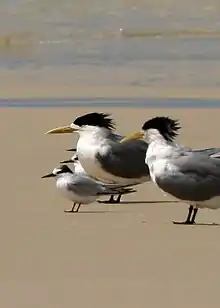
37 species recorded [25 extant native, 12 vagrant]
Laridae is a family of medium to large seabirds, the gulls, terns, and skimmers. Gulls are typically grey or white, often with black markings on the head or wings. They have stout, longish bills and webbed feet. Terns are a group of generally medium to large seabirds typically with grey or white plumage, often with black markings on the head. Most terns hunt fish by diving but some pick insects off the surface of fresh water. Terns are generally long-lived birds, with several species known to live in excess of 30 years. Skimmers are a small family of tropical tern-like birds. They have an elongated lower mandible which they use to feed by flying low over the water surface and skimming the water for small fish.
| Common name | Binomial | Notes |
|---|---|---|
| Sabine's gull | Xema sabini | vagrant |
| Silver gull | Chroicocephalus novaehollandiae | |
| Black-headed gull | Chroicocephalus ridibundus | vagrant |
| Laughing gull | Leucophaeus atricilla | vagrant |
| Franklin's gull | Leucophaeus pipixcan | vagrant |
| Black-tailed gull | Larus crassirostris | vagrant |
| Pacific gull | Larus pacificus | |
| Mew gull | Larus canus | vagrant, Christmas Island |
| Lesser black-backed gull | Larus fuscus | vagrant, Cocos (Keeling) Islands & possibly mainland |
| Slaty-backed gull | Larus schistisagus | vagrant |
| Kelp gull | Larus dominicanus | |
| Brown noddy | Anous stolidus | |
| Black noddy | Anous minutus | |
| Lesser noddy | Anous tenuirostris | |
| Grey noddy | Anous albivitta | |
| Blue-grey noddy | Anous ceruleus | |
| White tern | Gygis alba | Lord Howe, Norfolk & Cocos (Keeling) Islands; mainland vagrant |
| Sooty tern | Onychoprion fuscata | |
| Grey-backed tern | Onychoprion lunatus | vagrant |
| Bridled tern | Onychoprion anaethetus | |
| Aleutian tern | Onychoprion aleuticus | vagrant |
| Little tern | Sternula albifrons | |
| Australian fairy tern | Sternula nereis | |
| Saunders's tern | Sternula saundersi | Cocos (Keeling) Islands |
| Gull-billed tern | Gelochelidon nilotica | is a mainland vagrant |
| Caspian tern | Hydroprogne caspia | |
| Black tern | Chlidonias niger | vagrant |
| White-winged tern | Chlidonias leucopterus | |
| Whiskered tern | Chlidonias hybrida | |
| Roseate tern | Sterna dougallii | |
| White-fronted tern | Sterna striata | |
| Black-naped tern | Sterna sumatrana | |
| Common tern | Sterna hirundo | |
| Arctic tern | Sterna paradisaea | vagrant |
| Antarctic tern | Sterna vittata | Macquarie & Heard Island; mainland vagrant |
| Great crested tern | Thalasseus bergii | |
| Lesser crested tern | Thalasseus bengalensis |
Tropicbirds
Order: Phaethontiformes Family: Phaethontidae
3 species recorded [2 extant native, 1 vagrant]
Tropicbirds are slender white birds of tropical oceans, with exceptionally long central tail feathers. Their long wings have black markings, as does the head. Three species have been recorded from Australian waters.
| Common name | Binomial | Notes |
|---|---|---|
| White-tailed tropicbird | Phaethon lepturus | |
| Red-billed tropicbird | Phaethon aethereus | vagrant, Ashmore Reef & Lord Howe Island |
| Red-tailed tropicbird | Phaethon rubricauda |
Penguins
Order: Sphenisciformes Family: Spheniscidae
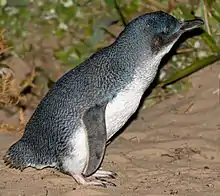
14 species recorded [6 extant native, 8 vagrant]
Penguins are a group of aquatic, flightless birds living almost exclusively in the Southern Hemisphere, especially in Antarctica. Only one species, the little penguin, breeds on the Australian coast.
| Common name | Binomial | Notes |
|---|---|---|
| King penguin | Aptenodytes patagonicus | Macquarie & Heard Island; mainland vagrant |
| Emperor penguin | Aptenodytes forsteri | vagrant, Macquarie & Heard Island |
| Adelie penguin | Pygoscelis adeliae | vagrant, TAS, Macquarie & Heard Island |
| Gentoo penguin | Pygoscelis papua | Macquarie & Heard Island; mainland vagrant |
| Chinstrap penguin | Pygoscelis antarcticus | vagrant, VIC, TAS, Macquarie & Heard Island |
| Little penguin | Eudyptula minor | |
| Magellanic penguin | Spheniscus magellanicus | vagrant |
| Fiordland penguin | Eudyptes pachyrhynchus | |
| Erect-crested penguin | Eudyptes sclateri | vagrant |
| Macaroni penguin | Eudyptes chrysolophus | vagrant; Macquarie Island; Heard Island |
| Royal penguin | Eudyptes schlegeli | Macquarie Island; mainland vagrant |
| Southern rockhopper penguin | Eudyptes chrysocome | Macquarie & Heard Island; mainland vagrant |
| Moseley's rockhopper penguin | Eudyptes moseleyi | vagrant |
| Snares penguin | Eudyptes robustus | vagrant |
Albatrosses
Order: Procellariiformes Family: Diomedeidae
13 species recorded [11 extant native, 2 vagrant]
The albatrosses are a family of large seabird found across the Southern and North Pacific Oceans. The largest are among the largest flying birds in the world. Thirteen species are seen to varying degrees in Australian waters, with two recorded as vagrants.
| Common name | Binomial | Notes |
|---|---|---|
| Yellow-nosed albatross | Thalassarche chlororhynchos | |
| Grey-headed albatross | Thalassarche chrysostoma | |
| Buller's albatross | Thalassarche bulleri | |
| White-capped albatross | Thalassarche cauta | |
| Salvin's albatross | Thalassarche salvini | |
| Chatham albatross | Thalassarche eremita | vagrant |
| Campbell albatross | Thalassarche impavida | |
| Black-browed albatross | Thalassarche melanophris | |
| Sooty albatross | Phoebetria fusca | |
| Light-mantled albatross | Phoebetria palpebrata | |
| Royal albatross | Diomedea epomophora | |
| Wandering albatross | Diomedea exulans | |
| Laysan albatross | Phoebastria immutabilis | vagrant, Norfolk Island |
Southern storm-petrels
Order: Procellariiformes Family: Oceanitidae
7 species recorded [5 extant native, 2 vagrant]
The southern storm-petrels are the smallest seabirds, relatives of the petrels, feeding on planktonic crustaceans and small fish picked from the surface, typically while hovering. Their flight is fluttering and sometimes bat-like.
| Common name | Binomial | Notes |
|---|---|---|
| Wilson's storm-petrel | Oceanites oceanicus | |
| Grey-backed storm-petrel | Garrodia nereis | |
| White-faced storm-petrel | Pelagodroma marina | |
| White-bellied storm-petrel | Fregetta grallaria | |
| New Zealand storm-petrel | Fregetta maoriana | vagrant |
| Black-bellied storm-petrel | Fregetta tropica | |
| Polynesian storm-petrel | Nesofregetta fuliginosa | vagrant |
Northern storm-petrels
Order: Procellariiformes Family: Hydrobatidae
5 species recorded [2 extant native, 3 vagrant]
Though the members of this family are similar in many respects to the southern storm-petrels, including their general appearance and habits, there are enough genetic differences to warrant their placement in a separate family.
| Common name | Binomial | Notes |
|---|---|---|
| Leach's storm-petrel | Oceanodroma leucorhoa | vagrant |
| Swinhoe's storm-petrel | Oceanodroma monorhis | |
| Band-rumped storm-petrel | Oceanodroma castro | vagrant |
| Matsudaira's storm-petrel | Oceanodroma matsudairae | |
| Tristram's storm-petrel | Oceanodroma tristrami | vagrant |
Shearwaters and petrels
Order: Procellariiformes Family: Procellariidae
61 species recorded [41 native extant, 19 vagrant, 1 extirpated]
The procellariids are the main group of medium-sized "true petrels", characterised by united nostrils with medium nasal septum, and a long outer functional primary flight feather.
| Common name | Binomial | Notes |
|---|---|---|
| Southern giant-petrel | Macronectes giganteus | |
| Northern giant-petrel | Macronectes halli | |
| Southern fulmar | Fulmarus glacialoides | |
| Antarctic petrel | Thalassoica antarctica | vagrant |
| Cape petrel | Daption capense | |
| Snow petrel | Pagodroma nivea | vagrant, Heard & Macquarie Island |
| Kerguelen petrel | Aphrodroma brevirostris | |
| Great-winged petrel | Pterodroma macroptera | |
| Grey-faced petrel | Pterodroma gouldi | vagrant |
| Kermadec petrel | Pterodroma neglecta | vagrant; Lord Howe Island; Norfolk Island |
| Trindade petrel | Pterodroma arminjoniana | vagrant |
| Herald petrel | Pterodroma heraldica | |
| Providence petrel | Pterodroma solandri | |
| Soft-plumaged petrel | Pterodroma mollis | |
| Barau's petrel | Pterodroma baraui | vagrant |
| White-headed petrel | Pterodroma lessonii | |
| Mottled petrel | Pterodroma inexpectata | |
| Juan Fernandez petrel | Pterodroma externa | vagrant |
| Atlantic petrel | Pterodroma incerta | vagrant |
| White-necked petrel | Pterodroma cervicalis | |
| Black-winged petrel | Pterodroma nigripennis | |
| Cook's petrel | Pterodroma cookii | |
| Gould's petrel | Pterodroma leucoptera | |
| Collared petrel | Pterodroma brevipes | vagrant |
| Stejneger's petrel | Pterodroma longirostris | vagrant |
| Pycroft's petrel | Pterodroma pycrofti | extirpated, Norfolk Island; possible vagrant |
| Vanuatu petrel | Pterodroma occulta | vagrant |
| Blue petrel | Halobaena caerulea | |
| Fairy prion | Pachyptila turtur | |
| Broad-billed prion | Pachyptila vittata | |
| Salvin's prion | Pachyptila salvini | |
| Antarctic prion | Pachyptila desolata | |
| Slender-billed prion | Pachyptila belcheri | |
| Fulmar prion | Pachyptila crassirostris | vagrant; Heard Island |
| Bulwer's petrel | Bulweria bulwerii | |
| Jouanin's petrel | Bulweria fallax | |
| Tahiti petrel | Pseudobulweria rostrata | |
| Grey petrel | Procellaria cinerea | |
| White-chinned petrel | Procellaria aequinoctialis | |
| Parkinson's petrel | Procellaria parkinsoni | |
| Westland petrel | Procellaria westlandica | |
| Streaked shearwater | Calonectris leucomelas | |
| Cory's shearwater | Calonectris borealis | vagrant |
| Pink-footed shearwater | Ardenna creatopus | vagrant |
| Flesh-footed shearwater | Ardenna carneipes | |
| Great shearwater | Ardenna gravis | vagrant |
| Wedge-tailed shearwater | Ardenna pacifica | |
| Buller's shearwater | Ardenna bulleri | |
| Sooty shearwater | Ardenna grisea | |
| Short-tailed shearwater | Ardenna tenuirostris | |
| Manx shearwater | Puffinus puffinus | vagrant |
| Hutton's shearwater | Puffinus huttoni | |
| Newell's shearwater | Puffinus newelli | vagrant |
| Fluttering shearwater | Puffinus gavia | |
| Little shearwater | Puffinus assimilis | |
| Subantarctic shearwater | Puffinus elegans | |
| Tropical shearwater | Puffinus bailloni | vagrant |
| Persian shearwater | Puffinus persicus | possible vagrant |
| Heinroth's shearwater | Puffinus heinrothi | vagrant |
| Common diving-petrel | Pelecanoides urinatrix | |
| South Georgian diving-petrel | Pelecanoides georgicus | Macquarie & Heard Island; mainland vagrant |
Storks
_-_Fogg_Dam_-_Northern_Territory_-_Australia_%2526_Juvenile_Pied_Heron_in_flight.jpg.webp)
Order: Ciconiiformes Family: Ciconiidae
1 species recorded [1 extant native]
Storks are large, long-legged, long-necked, wading birds with long, stout bills. Storks are mute, but bill-clattering is an important mode of communication at the nest. Their nests can be large and may be reused for many years.
| Common name | Binomial | Notes |
|---|---|---|
| Black-necked stork | Ephippiorhynchus asiaticus |
Frigatebirds
Order: Suliformes Family: Fregatidae
3 species recorded [3 extant native]
Frigatebirds are large seabirds usually found over tropical oceans. They are large, black, or black-and-white, with long wings and deeply forked tails. The males have coloured inflatable throat pouches. They do not swim or walk and cannot take off from a flat surface. Having the largest wingspan-to-body-weight ratio of any bird, they are essentially aerial, able to stay aloft for more than a week.
| Common name | Binomial | Notes |
|---|---|---|
| Lesser frigatebird | Fregata ariel | |
| Christmas Island frigatebird | Fregata andrewsi | Christmas Island; mainland vagrant |
| Great frigatebird | Fregata minor |
Boobies and gannets
Order: Suliformes Family: Sulidae
6 species recorded [5 extant native, 1 vagrant]
The sulids comprise the gannets and boobies. Both groups are medium-large coastal seabirds that plunge-dive for fish. Six species have been recorded from Australian territory.
| Common name | Binomial | Notes |
|---|---|---|
| Masked booby | Sula dactylatra | |
| Brown booby | Sula leucogaster | |
| Red-footed booby | Sula sula | |
| Abbott's booby | Papasula abbotti | Christmas Island; mainland vagrant |
| Cape gannet | Morus capensis | vagrant |
| Australasian gannet | Morus serrator |
Anhingas
Order: Suliformes Family: Anhingidae
2 species recorded [1 extant native, 1 vagrant]
Anhingas or darters are cormorant-like water birds with long necks and long, straight bills. They are fish eaters which often swim with only their neck above the water. One species is found in Australia.
| Common name | Binomial | Notes |
|---|---|---|
| Oriental darter | Anhinga melanogaster | vagrant |
| Australasian darter | Anhinga novaehollandiae |
Cormorants and shags
Order: Suliformes Family: Phalacrocoracidae
9 species recorded [7 extant native, 2 vagrant]
Cormorants are medium-to-large aquatic birds, usually with mainly dark plumage and areas of coloured skin on the face. The bill is long, thin and sharply hooked. Their feet are four-toed and webbed, a distinguishing feature among the order Pelecaniformes. Nine species occur in Australian territory, with two as vagrants.
| Common name | Binomial | Notes |
|---|---|---|
| Little pied cormorant | Microcarbo melanoleucos | |
| Great cormorant | Phalacrocorax carbo | |
| Spotted shag | Phalacrocorax punctatus | vagrant |
| Little black cormorant | Phalacrocorax sulcirostris | |
| Pied cormorant | Phalacrocorax varius | |
| Black-faced cormorant | Phalacrocorax fuscescens | |
| Imperial shag | Leucocarbo atriceps | Heard & Macquarie Island |
| Kerguelen shag | Phalacrocorax verrucosus | vagrant |
| Macquarie shag | Phalacrocorax purpurascens |
Pelicans
Order: Pelecaniformes Family: Pelecanidae
1 species recorded [1 extant native]
Pelicans are large water birds with distinctive pouches under their bills. Like other birds in the order Pelecaniformes, they have four webbed toes. One species has been recorded in Australia.
| Common name | Binomial | Notes |
|---|---|---|
| Australian pelican | Pelecanus conspicillatus |
Herons, egrets, and bitterns
Order: Pelecaniformes Family: Ardeidae
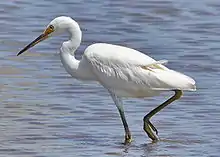
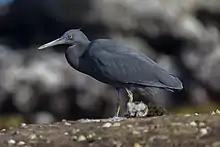
25 species recorded [15 extant native, 10 vagrant]
The family Ardeidae contains the bitterns, herons, and egrets. Herons and egrets are medium to large wading birds with long necks and legs. Bitterns tend to be shorter necked and more wary. Members of Ardeidae fly with their necks retracted, unlike other long-necked birds such as storks, ibises, and spoonbills.
| Common name | Binomial | Notes |
|---|---|---|
| Australasian bittern | Botaurus poiciloptilus | |
| Yellow bittern | Ixobrychus sinensis | vagrant |
| Black-backed bittern | Ixobrychus dubius | |
| Schrenck's bittern | Ixobrychus eurhythmus | vagrant, Christmas Island |
| Cinnamon bittern | Ixobrychus cinnamomeus | vagrant |
| Black bittern | Ixobrychus flavicollis | |
| Grey heron | Ardea cinerea | vagrant |
| Pacific heron | Ardea pacifica | |
| Great-billed heron | Ardea sumatrana | |
| Purple heron | Ardea purpurea | vagrant |
| Great egret | Ardea alba | |
| Intermediate egret | Ardea intermedia | |
| White-faced heron | Egretta novaehollandiae | |
| Little egret | Egretta garzetta | |
| Western reef-heron | Egretta gularis | possibly Cocos (Keeling) Islands but likely hybridised with E. sacra |
| Pacific reef-heron | Egretta sacra | |
| Pied heron | Egretta picata | |
| Cattle egret | Bubulcus ibis | |
| Chinese pond-heron | Ardeola bacchus | vagrant |
| Javan pond-heron | Ardeola speciosa | vagrant |
| Striated heron | Butorides striatus | |
| Black-crowned night-heron | Nycticorax nycticorax | vagrant, Cocos (Keeling) Islands & Ashmore Reef |
| Rufous night-heron | Nycticorax caledonicus | |
| Japanese night-heron | Gorsachius goisagi | vagrant, Christmas Island |
| Malayan night-heron | Gorsachius melanolophus | vagrant, Christmas Island |
Ibises and spoonbills
Order: Pelecaniformes Family: Threskiornithidae
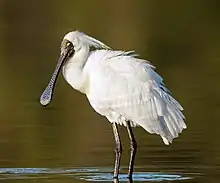
5 species recorded [5 extant native]
Threskiornithidae is a family of large terrestrial and wading birds which includes the ibises and spoonbills. They have long, broad wings with 11 primary and about 20 secondary feathers. They are strong fliers and despite their size and weight, very capable soarers.
| Common name | Binomial | Notes |
|---|---|---|
| Glossy ibis | Plegadis falcinellus | |
| Australian ibis | Threskiornis moluccus | |
| Straw-necked ibis | Threskiornis spinicollis | |
| Royal spoonbill | Platalea regia | |
| Yellow-billed spoonbill | Platalea flavipes |
Osprey
Order: Accipitriformes Family: Pandionidae
1 species recorded [1 extant native]
The family Pandionidae contains only one species, the osprey. The osprey is a medium-large raptor which is a specialist fish-eater with a worldwide distribution.
| Common name | Binomial | Notes |
|---|---|---|
| Osprey | Pandion haliaetus |
Hawks, eagles, and kites
Order: Accipitriformes Family: Accipitridae
22 species recorded [17 extant native, 5 vagrant]
Accipitridae is a family of birds of prey, which includes hawks, eagles, kites, harriers, and Old World vultures. These birds have powerful hooked beaks for tearing flesh from their prey, strong legs, powerful talons, and keen eyesight.
| Common name | Binomial | Notes |
|---|---|---|
| Black-shouldered kite | Elanus axillaris | |
| Letter-winged kite | Elanus scriptus | |
| Oriental honey-buzzard | Pernis ptilorhynchus | vagrant |
| Black-breasted kite | Hamirostra melanosternon | |
| Long-tailed honey-buzzard | Henicopernis longicauda | vagrant |
| Square-tailed kite | Lophoictinia isura | |
| Pacific baza | Aviceda subcristata | |
| Little eagle | Hieraaetus morphnoides | |
| Gurney's eagle | Aquila gurneyi | vagrant, Torres Strait |
| Wedge-tailed eagle | Aquila audax | |
| Swamp harrier | Circus approximans | |
| Spotted harrier | Circus assimilis | |
| Chinese sparrowhawk | Accipiter soloensis | vagrant, Cocos (Keeling) Islands & Ashmore Reef |
| Grey goshawk | Accipiter novaehollandiae | |
| Brown goshawk | Accipiter fasciatus | |
| Japanese sparrowhawk | Accipiter gularis | vagrant, Cocos (Keeling) Islands & Ashmore Reef |
| Collared sparrowhawk | Accipiter cirrocephalus | |
| Red goshawk | Erythrotriorchis radiatus | |
| Black kite | Milvus migrans | |
| Whistling kite | Haliastur sphenurus | |
| Brahminy kite | Haliastur indus | |
| White-bellied sea eagle | Haliaeetus leucogaster |
Barn-owls
Order: Strigiformes Family: Tytonidae
4 species recorded [4 extant native]
Barn-owls are medium to large owls with large heads and characteristic heart-shaped faces. They have long strong legs with powerful talons.
| Common name | Binomial | Notes |
|---|---|---|
| Sooty owl | Tyto tenebricosa | |
| Australian masked-owl | Tyto novaehollandiae | |
| Australasian grass-owl | Tyto longimembris | |
| Barn owl | Tyto alba |
Owls
Order: Strigiformes Family: Strigidae
10 species recorded [6 extant native, 4 vagrant]
The typical owls are small to large solitary nocturnal birds of prey. They have large forward-facing eyes and ears, a hawk-like beak, and a conspicuous circle of feathers around each eye called a facial disk.
| Common name | Binomial | Notes |
|---|---|---|
| Oriental scops-owl | Otis sunia | vagrant, Barrow Island, WA |
| Buffy fish-owl | Ketupa ketupu | vagrant, Cocos (Keeling) Islands |
| Rufous owl | Ninox rufa | |
| Powerful owl | Ninox strenua | |
| Barking owl | Ninox connivens | |
| Australian boobook | Ninox boobook | |
| Morepork | Ninox novaeseelandiae | |
| Brown boobook | Ninox scutulata | vagrant |
| Northern boobook | Ninox japonica | vagrant |
| Christmas Island boobook | Ninox natalis | Christmas Island |
Hoopoes
Order: Bucerotiformes Family: Upupidae
1 species recorded [1 vagrant]
Hoopoes have black, white, and orangey-pink colouring with a large erectile crest on their head.
| Common name | Binomial | Notes |
|---|---|---|
| Eurasian hoopoe | Upupa epops | vagrant |
Kingfishers
Order: Coraciiformes Family: Alcedinidae
15 species recorded [11 extant native, 4 vagrant]
Kingfishers are medium-sized birds with large heads, long pointed bills, short legs, and stubby tails.
| Common name | Binomial | Notes |
|---|---|---|
| Common kingfisher | Alcedo atthis | vagrant, Christmas & Cocos (Keeling) Islands |
| Azure kingfisher | Ceyx azureus | |
| Little kingfisher | Ceyx pusillus | |
| Laughing kookaburra | Dacelo novaeguineae | |
| Blue-winged kookaburra | Dacelo leachii | |
| Black-capped kingfisher | Halcyon pileata | vagrant |
| Red-backed kingfisher | Todiramphus pyrrhopygia | |
| Forest kingfisher | Todiramphus macleayii | |
| Torresian kingfisher | Todiramphus sordidus | |
| Sacred kingfisher | Todiramphus sanctus | |
| Collared kingfisher | Todiramphus chloris | |
| Yellow-billed kingfisher | Syma torotoro | |
| Little paradise-kingfisher | Tanysiptera hydrocharis | vagrant, Torres Strait |
| Common paradise-kingfisher | Tanysiptera galatea | vagrant, Torres Strait |
| Buff-breasted paradise-kingfisher | Tanysiptera sylvia |
Bee-eaters

Order: Coraciiformes Family: Meropidae
1 species recorded [1 extant native]
The bee-eaters are a group of near passerine birds in the family Meropidae. Most species are found in Africa but others occur in southern Europe, Madagascar, Australia, and New Guinea. They are characterised by richly coloured plumage, slender bodies, and usually elongated central tail feathers. All are colourful and have long downturned bills and pointed wings, which give them a swallow-like appearance when seen from afar.
| Common name | Binomial | Notes |
|---|---|---|
| Rainbow bee-eater | Merops ornatus |
Rollers
Order: Coraciiformes Family: Coraciidae
2 species recorded [1 extant native, 1 vagrant]
Rollers resemble crows in size and build, but are more closely related to the kingfishers and bee-eaters. They share the colourful appearance of those groups with blues and browns predominating. The two inner front toes are connected, but the outer toe is not.
| Common name | Binomial | Notes |
|---|---|---|
| European roller | Coracias garrulus | vagrant, Cocos (Keeling) Islands |
| Dollarbird | Eurystomus orientalis |
Falcons and caracaras
Order: Falconiformes Family: Falconidae
7 species recorded [6 extant native, 1 vagrant]
Falconidae is a family of diurnal birds of prey. They differ from hawks, eagles, and kites in that they kill with their beaks instead of their talons.
| Common name | Binomial | Notes |
|---|---|---|
| Australian kestrel | Falco cenchroides | |
| Eurasian hobby | Falco subbuteo | vagrant |
| Australian hobby | Falco longipennis | |
| Brown falcon | Falco berigora | |
| Grey falcon | Falco hypoleucos | |
| Black falcon | Falco subniger | |
| Peregrine falcon | Falco peregrinus |
New Zealand parrots
Order: Psittaciformes Family: Nestoridae
1 species recorded [1 extinct native]
The family diverged from the other parrots around 82 million years ago when New Zealand broke off from Gondwana, while the ancestors of the genera Nestor and Strigops diverged from each other between 60 and 80 million years ago.
| Common name | Binomial | Notes |
|---|---|---|
| Norfolk kaka | Nestor productus | extinct, Norfolk Island |
Cockatoos
Order: Psittaciformes Family: Cacatuidae
14 species recorded [14 extant native]
The cockatoos share many features with other parrots including the characteristic curved beak shape and a zygodactyl foot, with two forward toes and two backwards toes. They differ, however in a number of characteristics, including the often spectacular movable headcrest.
| Common name | Binomial | Notes |
|---|---|---|
| Palm cockatoo | Probosciger aterrimus | |
| Red-tailed black-cockatoo | Calyptorhynchus banksii | |
| Glossy black-cockatoo | Calyptorhynchus lathami | |
| Yellow-tailed black-cockatoo | Calyptorhynchus funereus | |
| Carnaby's black-cockatoo | Calyptorhynchus latirostris | |
| Baudin's black-cockatoo | Calyptorhynchus baudinii | |
| Gang-gang cockatoo | Callocephalon fimbriatum | |
| Pink cockatoo | Lophochroa leadbeateri | |
| Galah | Eolophus roseicapilla | |
| Long-billed corella | Cacatua tenuirostris | |
| Western corella | Cacatua pastinator | |
| Little corella | Cacatua sanguinea | |
| Sulphur-crested cockatoo | Cacatua galerita | |
| Cockatiel | Nymphicus hollandicus |
Old World parrots
Order: Psittaciformes Family: Psittaculidae
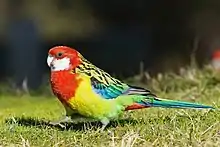
44 species recorded [42 extant native, 1 extirpated native, 1 extinct native]
Characteristic features of parrots include a strong curved bill, an upright stance, strong legs, and clawed zygodactyl feet. Many parrots are vividly coloured, and some are multi-coloured. In size they range from 8 cm (3.1 in) to 1 m (3.3 ft) in length. Old World parrots are found from Africa east across south and southeast Asia and Oceania to Australia and New Zealand.
| Common name | Binomial | Notes |
|---|---|---|
| Superb parrot | Polytelis swainsonii | |
| Regent parrot | Polytelis anthopeplus | |
| Princess parrot | Polytelis alexandrae | |
| Australian king-parrot | Alisterus scapularis | |
| Red-winged parrot | Aprosmictus erythropterus | |
| Eclectus parrot | Eclectus roratus | |
| Red-cheeked parrot | Geoffroyus geoffroyi | |
| Ground parrot | Pezoporus wallicus | |
| Night parrot | Pezoporus occidentalis | |
| Bourke's parrot | Neopsephotus bourkii | |
| Blue-winged parrot | Neophema chrysostoma | |
| Elegant parrot | Neophema elegans | |
| Rock parrot | Neophema petrophila | |
| Orange-bellied parrot | Neophema chrysogaster | |
| Turquoise parrot | Neophema pulchella | |
| Scarlet-chested parrot | Neophema splendida | |
| Swift parrot | Lathamus discolor | |
| Red-crowned parakeet | Cyanoramphus novaezelandiae | extirpated, Macquarie Island |
| Norfolk Island parakeet | Cyanoramphus cookii | Norfolk Island |
| Australian ringneck | Barnardius zonarius | |
| Green rosella | Platycercus caledonicus | |
| Crimson rosella | Platycercus elegans | |
| Northern rosella | Platycercus venustus | |
| Eastern rosella | Platycercus eximius | |
| Pale-headed rosella | Platycercus adscitus | |
| Western rosella | Platycercus icterotis | |
| Greater bluebonnet | Northiella haematogaster | |
| Naretha bluebonnet | Northiella narethae | |
| Red-rumped parrot | Psephotus haematonotus | |
| Mulga parrot | Psephotus varius | |
| Hooded parrot | Psephotus dissimilis | |
| Golden-shouldered parrot | Psephotus chrysopterygius | |
| Paradise parrot | Psephotus pulcherrimus | extinct |
| Red-capped parrot | Purpureicephalus spurius | |
| Double-eyed fig-parrot | Cyclopsitta diophthalma | |
| Budgerigar | Melopsittacus undulatus | |
| Musk lorikeet | Glossopsitta concinna | |
| Little lorikeet | Glossopsitta pusilla | |
| Purple-crowned lorikeet | Glossopsitta porphyrocephala | |
| Varied lorikeet | Psitteuteles versicolor | |
| Coconut lorikeet | Trichoglossus haematodus | Torres Strait |
| Red-collared lorikeet | Trichoglossus rubritorquis | |
| Rainbow lorikeet | Trichoglossus moluccanus | |
| Scaly-breasted lorikeet | Trichoglossus chlorolepidotus |
Pittas
Order: Passeriformes Family: Pittidae
6 species recorded [3 extant native, 3 vagrant]
Pittas are medium-sized by passerine standards and are stocky, with fairly long, strong legs, short tails, and stout bills. Many are brightly coloured. They spend the majority of their time on wet forest floors, eating snails, insects, and similar invertebrates.
| Common name | Binomial | Notes |
|---|---|---|
| Papuan pitta | Erythropitta macklotii | |
| Blue-winged pitta | Pitta moluccensis | vagrant |
| Fairy pitta | Pitta nympha | vagrant |
| Hooded pitta | Pitta sordida | vagrant, Barrow Island, WA |
| Noisy pitta | Pitta versicolor | |
| Rainbow pitta | Pitta iris |
Lyrebirds
Order: Passeriformes Family: Menuridae
2 species [2 extant native]
Lyrebirds are most notable for their superb ability to mimic natural and artificial sounds from their environment, and the striking beauty of the male bird's huge tail when it is fanned out in courtship display.
| Common name | Binomial | Notes |
|---|---|---|
| Albert's lyrebird | Menura alberti | |
| Superb lyrebird | Menura novaehollandiae |
Scrub-birds
Order: Passeriformes Family: Atrichornithidae
2 species recorded [2 extant native]
The scrub-bird family is ancient and is understood to be most closely related to the lyrebirds, and probably also the bowerbirds and treecreepers.
| Common name | Binomial | Notes |
|---|---|---|
| Rufous scrub-bird | Atrichornis rufescens | |
| Noisy scrub-bird | Atrichornis clamosus |
Bowerbirds
Order: Passeriformes Family: Ptilonorhynchidae
11 species recorded [11 extant native]
The bowerbirds are small to medium-sized passerine birds. The males notably build a bower to attract a mate. Depending on the species, the bower ranges from a circle of cleared earth with a small pile of twigs in the center to a complex and highly decorated structure of sticks and leaves.
| Common name | Binomial | Notes |
|---|---|---|
| Spotted catbird | Ailuroedus maculosus | |
| Black-eared catbird | Ailuroedus melanotis | |
| Green catbird | Ailuroedus crassirostris | |
| Tooth-billed bowerbird | Scenopoeetes dentirostris | |
| Golden bowerbird | Amblyornis newtonianus | |
| Regent bowerbird | Sericulus chrysocephalus | |
| Satin bowerbird | Ptilonorhynchus violaceus | |
| Western bowerbird | Ptilonorhynchus guttatus | |
| Spotted bowerbird | Ptilonorhynchus maculatus | |
| Great bowerbird | Ptilonorhynchus nuchalis | |
| Fawn-breasted bowerbird | Ptilonorhynchus cerviniventris |
Australasian treecreepers
Order: Passeriformes Family: Climacteridae
6 species recorded [6 extant native]
The Climacteridae are medium-small, mostly brown-coloured birds with patterning on their underparts.
| Common name | Binomial | Notes |
|---|---|---|
| White-throated treecreeper | Cormobates leucophaea | |
| White-browed treecreeper | Climacteris affinis | |
| Red-browed treecreeper | Climacteris erythrops | |
| Brown treecreeper | Climacteris picumnus | |
| Black-tailed treecreeper | Climacteris melanura | |
| Rufous treecreeper | Climacteris rufa |
Fairywrens
Order: Passeriformes Family: Maluridae
27 species recorded [27 extant native]
Maluridae is a family of small, insectivorous passerine birds endemic to Australia and New Guinea. They are socially monogamous and sexually promiscuous, meaning that although they form pairs between one male and one female, each partner will mate with other individuals and even assist in raising the young from such pairings.
| Common name | Binomial | Notes |
|---|---|---|
| Grey grasswren | Amytornis barbatus | |
| Pilbara grasswren | Amytornis whitei | |
| Sandhill grasswren | Amytornis oweni | |
| Rusty grasswren | Amytornis rowleyi | |
| Striated grasswren | Amytornis striatus | |
| White-throated grasswren | Amytornis woodwardi | |
| Carpentarian grasswren | Amytornis dorotheae | |
| Short-tailed grasswren | Amytornis merrotsyi | |
| Western grasswren | Amytornis textilis | |
| Thick-billed grasswren | Amytornis modestus | |
| Black grasswren | Amytornis housei | |
| Eyrean grasswren | Amytornis goyderi | |
| Dusky grasswren | Amytornis purnelli | |
| Kalkadoon grasswren | Amytornis ballarae | |
| Southern emuwren | Stipiturus malachurus | |
| Rufous-crowned emuwren | Stipiturus ruficeps | |
| Mallee emuwren | Stipiturus mallee | |
| Purple-crowned fairywren | Malurus coronatus | |
| Red-winged fairywren | Malurus elegans | |
| Blue-breasted fairywren | Malurus pulcherrimus | |
| Purple-backed fairywren | Malurus assimilis | |
| Variegated fairywren | Malurus lamberti | |
| Lovely fairywren | Malurus amabilis | |
| Splendid fairywren | Malurus splendens | |
| Superb fairywren | Malurus cyaneus | |
| White-winged fairywren | Malurus leucopterus | |
| Red-backed fairywren | Malurus melanocephalus |
Honeyeaters
Order: Passeriformes Family: Meliphagidae
75 species recorded [75 extant native]
The honeyeaters are a large and diverse family of small to medium-sized birds most common in Australia and New Guinea. They are nectar feeders and closely resemble other nectar-feeding passerines.
| Common name | Binomial | Notes |
|---|---|---|
| Eastern spinebill | Acanthorhynchus tenuirostris | |
| Western spinebill | Acanthorhynchus superciliosus | |
| Pied honeyeater | Certhionyx variegatus | |
| Yellow-spotted honeyeater | Meliphaga notata | |
| Lewin's honeyeater | Meliphaga lewinii | |
| White-lined honeyeater | Meliphaga albilineata | |
| Kimberley honeyeater | Meliphaga fordiana | |
| Graceful honeyeater | Meliphaga gracilis | |
| Yellow honeyeater | Stomiopera flava | |
| White-gaped honeyeater | Stomiopera unicolor | |
| White-fronted honeyeater | Purnella albifrons | |
| Yellow-faced honeyeater | Caligavis chrysops | |
| Yellow-tufted honeyeater | Lichenostomus melanops | |
| Purple-gaped honeyeater | Lichenostomus cratitius | |
| Bell miner | Manorina melanophrys | |
| Noisy miner | Manorina melanocephala | |
| Yellow-throated miner | Manorina flavigula | |
| Black-eared miner | Manorina melanotis | |
| Bridled honeyeater | Bolemoreus frenatus | |
| Eungella honeyeater | Bolemoreus hindwoodi | |
| Spiny-cheeked honeyeater | Acanthagenys rufogularis | |
| Little wattlebird | Anthochaera chrysoptera | |
| Western wattlebird | Anthochaera lunulata | |
| Regent honeyeater | Anthochaera phrygia | |
| Red wattlebird | Anthochaera carunculata | |
| Yellow wattlebird | Anthochaera paradoxa | |
| Varied honeyeater | Gavicalis versicolor | |
| Mangrove honeyeater | Gavicalis fasciogularis | |
| Singing honeyeater | Gavicalis virescens | |
| Yellow-plumed honeyeater | Ptilotula ornata | |
| White-plumed honeyeater | Ptilotula penicillata | |
| Yellow-tinted honeyeater | Ptilotula flavescens | |
| Fuscous honeyeater | Ptilotula fusca | |
| Grey-headed honeyeater | Ptilotula keartlandi | |
| Grey-fronted honeyeater | Ptilotula plumula | |
| Brown-backed honeyeater | Ramsayornis modestus | |
| Bar-breasted honeyeater | Ramsayornis fasciatus | |
| Rufous-banded honeyeater | Conopophila albogularis | |
| Rufous-throated honeyeater | Conopophila rufogularis | |
| Grey honeyeater | Conopophila whitei | |
| Gibber chat | Ashbyia lovensis | |
| Yellow chat | Epthianura crocea | |
| Crimson chat | Epthianura tricolor | |
| Orange chat | Epthianura aurifrons | |
| White-fronted chat | Epthianura albifrons | |
| Black honeyeater | Sugomel nigrum | |
| Dusky honeyeater | Myzomela obscura | |
| Red-headed honeyeater | Myzomela erythrocephala | |
| Scarlet honeyeater | Myzomela sanguinolenta | |
| Tawny-crowned honeyeater | Gliciphila melanops | |
| Green-backed honeyeater | Glycichaera fallax | |
| Banded honeyeater | Cissomela pectoralis | |
| Brown honeyeater | Lichmera indistincta | |
| Crescent honeyeater | Phylidonyris pyrrhoptera | |
| New Holland honeyeater | Phylidonyris novaehollandiae | |
| White-cheeked honeyeater | Phylidonyris niger | |
| White-streaked honeyeater | Trichodere cockerelli | |
| White-eared honeyeater | Nesoptilotis leucotis | |
| Yellow-throated honeyeater | Nesoptilotis flavicollis | |
| Blue-faced honeyeater | Entomyzon cyanotis | |
| White-throated honeyeater | Melithreptus albogularis | |
| Gilbert's honeyeater | Melithreptus chloropsis | |
| White-naped honeyeater | Melithreptus lunatus | |
| Black-headed honeyeater | Melithreptus affinis | |
| Brown-headed honeyeater | Melithreptus brevirostris | |
| Black-chinned honeyeater | Melithreptus gularis | |
| Strong-billed honeyeater | Melithreptus validirostris | |
| Tawny-breasted honeyeater | Xanthotis flaviventer | |
| Macleay's honeyeater | Xanthotis macleayana | |
| Striped honeyeater | Plectorhyncha lanceolata | |
| Painted honeyeater | Grantiella picta | |
| Little friarbird | Philemon citreogularis | |
| Helmeted friarbird | Philemon buceroides | |
| Silver-crowned friarbird | Philemon argenticeps | |
| Noisy friarbird | Philemon corniculatus |
Bristlebirds
Order: Passeriformes Family: Dasyornithidae
3 species recorded [3 extant native]
Bristlebirds are long-tailed, sedentary, ground-frequenting birds. The common name of the family is derived from the presence of prominent rictal bristles - three stiff, hair-like feathers curving downwards on either side of the gape.
| Common name | Binomial | Notes |
|---|---|---|
| Western bristlebird | Dasyornis longirostris | |
| Eastern bristlebird | Dasyornis brachypterus | |
| Rufous bristlebird | Dasyornis broadbenti |
Pardalotes
Order: Passeriformes Family: Pardalotidae
4 species recorded [4 extant native]
Pardalotes spend most of their time high in the outer foliage of trees, feeding on insects, spiders, and above all lerps (a type of sap-sucking insect).
| Common name | Binomial | Notes |
|---|---|---|
| Spotted pardalote | Pardalotus punctatus | |
| Forty-spotted pardalote | Pardalotus quadragintus | |
| Red-browed pardalote | Pardalotus rubricatus | |
| Striated pardalote | Pardalotus striatus |
Thornbills and allies
Order: Passeriformes Family: Acanthizidae
44 species recorded [43 extant native, 1 extinct native]
Thornbills are small passerine birds, similar in habits to the tits.
| Common name | Binomial | Notes |
|---|---|---|
| Pilotbird | Pycnoptilus floccosus | |
| Rockwarbler | Origma solitaria | |
| Fernwren | Oreoscopus gutturalis | |
| Yellow-throated scrubwren | Sericornis citreogularis | |
| White-browed scrubwren | Sericornis frontalis | |
| Tasmanian scrubwren | Sericornis humilis | |
| Atherton scrubwren | Sericornis keri | |
| Tropical scrubwren | Sericornis beccarii | |
| Large-billed scrubwren | Sericornis magnirostra | |
| Scrubtit | Acanthornis magna | |
| Redthroat | Pyrrholaemus brunneus | |
| Speckled warbler | Pyrrholaemus sagittatus | |
| Rufous fieldwren | Calamanthus campestris | |
| Western fieldwren | Calamanthus montanellus | |
| Striated fieldwren | Calamanthus fuliginosus | |
| Chestnut-rumped heathwren | Hylacola pyrrhopygia | |
| Shy heathwren | Hylacola cauta | |
| Buff-rumped thornbill | Acanthiza reguloides | |
| Western thornbill | Acanthiza inornata | |
| Slender-billed thornbill | Acanthiza iredalei | |
| Mountain thornbill | Acanthiza katherina | |
| Brown thornbill | Acanthiza pusilla | |
| Tasmanian thornbill | Acanthiza ewingii | |
| Inland thornbill | Acanthiza apicalis | |
| Yellow-rumped thornbill | Acanthiza chrysorrhoa | |
| Chestnut-rumped thornbill | Acanthiza uropygialis | |
| Slaty-backed thornbill | Acanthiza robustirostris | |
| Yellow thornbill | Acanthiza nana | |
| Striated thornbill | Acanthiza lineata | |
| Weebill | Smicrornis brevirostris | |
| Green-backed gerygone | Gerygone chloronota | |
| Fairy gerygone | Gerygone palpebrosa | |
| White-throated gerygone | Gerygone olivacea | |
| Yellow-bellied gerygone | Gerygone chrysogaster | |
| Large-billed gerygone | Gerygone magnirostris | |
| Dusky gerygone | Gerygone tenebrosa | |
| Brown gerygone | Gerygone mouki | |
| Western gerygone | Gerygone fusca | |
| Mangrove gerygone | Gerygone levigaster | |
| Norfolk Island gerygone | Gerygone modesta | Norfolk Island |
| Lord Howe gerygone | Gerygone insularis | extinct, Lord Howe Island |
| Southern whiteface | Aphelocephala leucopsis | |
| Chestnut-breasted whiteface | Aphelocephala pectoralis | |
| Banded whiteface | Aphelocephala nigricincta |
Pseudo-babblers
Order: Passeriformes Family: Pomatostomidae
4 species recorded [4 extant native]
The pseudo-babblers are small to medium-sized birds endemic to Australia and New Guinea. They are ground-feeding omnivores and highly social
| Common name | Binomial | Notes |
|---|---|---|
| Grey-crowned babbler | Pomatostomus temporalis | |
| White-browed babbler | Pomatostomus superciliosus | |
| Hall's babbler | Pomatostomus halli | |
| Chestnut-crowned babbler | Pomatostomus ruficeps |
Logrunners
Order: Passeriformes Family: Orthonychidae
2 species recorded [2 extant native]
The Orthonychidae is a family of birds with a single genus, Orthonyx, which comprises two types of passerine birds endemic to Australia and New Guinea, the logrunners and the chowchilla. Both use stiffened tails to brace themselves when feeding.
| Common name | Binomial | Notes |
|---|---|---|
| Australian logrunner | Orthonyx temminckii | |
| Chowchilla | Orthonyx spaldingii |
Quail-thrushes and jewel-babblers
Order: Passeriformes Family: Cinclosomatidae
7 species recorded [7 extant native]
The Cinclosomatidae is a family containing jewel-babblers and quail-thrushes.
| Common name | Binomial | Notes |
|---|---|---|
| Spotted quail-thrush | Cinclosoma punctatum | |
| Chestnut quail-thrush | Cinclosoma castanotum | |
| Copperback quail-thrush | Cinclosoma clarum | |
| Chestnut-breasted quail-thrush | Cinclosoma castaneothorax | |
| Western quail-thrush | Cinclosoma marginatum | |
| Cinnamon quail-thrush | Cinclosoma cinnamomeum | |
| Nullarbor quail-thrush | Cinclosoma alisteri |
Cuckooshrikes
Order: Passeriformes Family: Campephagidae
8 species recorded [7 extant native, 1 extirpated native]
The cuckooshrikes are small to medium-sized passerine birds. They are predominantly greyish with white and black, although some species are brightly coloured.
| Common name | Binomial | Notes |
|---|---|---|
| Ground cuckooshrike | Coracina maxima | |
| Barred cuckooshrike | Coracina lineata | |
| Black-faced cuckooshrike | Coracina novaehollandiae | |
| White-bellied cuckooshrike | Coracina papuensis | |
| Long-tailed triller | Lalage leucopyga | extirpated, Norfolk Island |
| White-winged triller | Lalage sueurii | |
| Varied triller | Lalage leucomela | |
| Common cicadabird | Edolisoma tenuirostre |
Sittellas
Order: Passeriformes Family: Neosittidae
2 species recorded [2 extant native]
The sittellas are a family of small passerine birds found only in Australasia. They resemble treecreepers, but have soft tails.
| Common name | Binomial | Notes |
|---|---|---|
| Papuan sittella | Daphoenositta papuensis | |
| Varied sittella | Daphoenositta chrysoptera |
Whipbirds and wedgebills
Order: Passeriformes Family: Psophodidae
4 species recorded [4 extant native]
The Psophodidae is a family containing whipbirds and wedgebills.
| Common name | Binomial | Notes |
|---|---|---|
| Eastern whipbird | Psophodes olivaceus | |
| Western whipbird | Psophodes nigrogularis | |
| Chiming wedgebill | Psophodes occidentalis | |
| Chirruping wedgebill | Psophodes cristatus |
Australo-Papuan bellbirds
Order: Passeriformes Family: Oreoicidae
1 species recorded [1 extant native]
The three species contained in the family have been moved around between different families for fifty years. A series of studies of the DNA of Australian birds between 2006 and 2001 found strong support for treating the three genera as a new family, which was formally named in 2016.
| Common name | Binomial | Notes |
|---|---|---|
| Crested bellbird | Oreoica gutturalis |
Shrike-tit
Order: Passeriformes Family: Falcunculidae
1 species recorded [1 extant native]
The crested shrike-tit has a parrot-like bill, used for distinctive bark-stripping behaviour, which gains it access to invertebrates.
| Common name | Binomial | Notes |
|---|---|---|
| Crested shrike-tit | Falcunculus frontatus |
Whistlers and allies
Order: Passeriformes Family: Pachycephalidae
13 species recorded [13 extant native]
The family Pachycephalidae includes the whistlers and shrike-thrushes.
| Common name | Binomial | Notes |
|---|---|---|
| Sandstone shrikethrush | Colluricincla woodwardi | |
| Bower's shrikethrush | Colluricincla boweri | |
| Grey shrikethrush | Colluricincla harmonica | |
| Little shrikethrush | Colluricincla megarhyncha | |
| Olive whistler | Pachycephala olivacea | |
| Red-lored whistler | Pachycephala rufogularis | |
| Gilbert's whistler | Pachycephala inornata | |
| Golden whistler | Pachycephala pectoralis | |
| Western whistler | Pachycephala occidentalis | |
| Black-tailed whistler | Pachycephala melanura | |
| Grey whistler | Pachycephala simplex | |
| Rufous whistler | Pachycephala rufiventris | |
| White-breasted whistler | Pachycephala lanioides |
Old World orioles
Order: Passeriformes Family: Oriolidae
3 species recorded [3 extant native]
The Old World orioles are colourful passerine birds. They are not related to the New World orioles.
| Common name | Binomial | Notes |
|---|---|---|
| Olive-backed oriole | Oriolus sagittatus | |
| Green oriole | Oriolus flavocinctus | |
| Australasian figbird | Sphecotheres vieilloti |
Boatbills
Order: Passeriformes Family: Machaerirhynchidae
1 species recorded [1 extant native]
The boatbills have affinities to woodswallows and butcherbirds, and are distributed across New Guinea and northern Queensland.
| Common name | Binomial | Notes |
|---|---|---|
| Yellow-breasted boatbill | Machaerirhynchus flaviventer |
Woodswallows, bellmagpies, and allies
Order: Passeriformes Family: Artamidae
15 species recorded [15 extant native]
The woodswallows are soft-plumaged, somber-coloured passerine birds. They are smooth, agile flyers with moderately large, semi-triangular wings. The cracticids: currawongs, bellmagpies and butcherbirds, are similar to the other corvids. They have large, straight bills and mostly black, white or grey plumage. All are omnivorous to some degree.
| Common name | Binomial | Notes |
|---|---|---|
| White-breasted woodswallow | Artamus leucorynchus | |
| Masked woodswallow | Artamus personatus | |
| White-browed woodswallow | Artamus superciliosus | |
| Black-faced woodswallow | Artamus cinereus | |
| Dusky woodswallow | Artamus cyanopterus | |
| Little woodswallow | Artamus minor | |
| Black-backed butcherbird | Cracticus mentalis | |
| Grey butcherbird | Cracticus torquatus | |
| Silver-backed butcherbird | Cracticus argenteus | |
| Pied butcherbird | Cracticus nigrogularis | |
| Black butcherbird | Melloria quoyi | |
| Australian magpie | Gymnorhina tibicen | |
| Pied currawong | Strepera graculina | |
| Black currawong | Strepera fuliginosa | |
| Grey currawong | Strepera versicolor |
Fantails
Order: Passeriformes Family: Rhipiduridae
7 species recorded [6 extant native, 1 extirpated]
The fantails are small insectivorous birds which are specialist aerial feeders.
| Common name | Binomial | Notes |
|---|---|---|
| Northern fantail | Rhipidura rufiventris | |
| Willie-wagtail | Rhipidura leucophrys | |
| Rufous fantail | Rhipidura rufifrons | |
| Arafura fantail | Rhipidura dryas | |
| Grey fantail | Rhipidura albiscapa | includes the Norfolk fantail R. a. pelzeni, which may be a subspecies of R. fuliginosa |
| Mangrove fantail | Rhipidura phasiana | |
| New Zealand fantail | Rhipidura fuliginosa | extirpated, Lord Howe Island; surviving Norfolk birds may be this species |
Drongos
Order: Passeriformes Family: Dicruridae
2 species recorded [1 extant native, 1 vagrant]
The drongos are mostly black or dark grey in colour, sometimes with metallic tints. They have long forked tails, and some Asian species have elaborate tail decorations. They have short legs and sit very upright when perched, like a shrike. They flycatch or take prey from the ground.
| Common name | Binomial | Notes |
|---|---|---|
| Crow-billed drongo | Dicrurus annectens | vagrant |
| Spangled drongo | Dicrurus bracteatus |
Birds-of-Paradise
Order: Passeriformes Family: Paradisaeidae
4 species recorded [4 extant native]
The birds-of-paradise are best known for the striking plumage possessed by the males of most species, in particular highly elongated and elaborate feathers extending from the tail, wings or head. These plumes are used in courtship displays to attract females.
| Common name | Binomial | Notes |
|---|---|---|
| Trumpet manucode | Phonygammus keraudrenii | |
| Paradise riflebird | Ptiloris paradiseus | |
| Victoria's riflebird | Ptiloris victoriae | |
| Magnificent riflebird | Ptiloris magnificus |
Monarch flycatchers
Order: Passeriformes Family: Monarchidae
15 species recorded [13 extant native, 2 vagrant]
The monarch flycatchers are small to medium-sized insectivorous passerines which hunt by flycatching.
| Common name | Binomial | Notes |
|---|---|---|
| White-eared monarch | Carterornis leucotis | |
| Island monarch | Monarcha cinerascens | vagrant |
| Black-faced monarch | Monarcha melanopsis | |
| Black-winged monarch | Monarcha frater | |
| Spectacled monarch | Symposiachrus trivirgatus | |
| Frilled monarch | Arses telescophthalmus | vagrant, Torres Strait |
| Frill-necked monarch | Arses lorealis | |
| Pied monarch | Arses kaupi | |
| Magpie-lark | Grallina cyanoleuca | |
| Leaden flycatcher | Myiagra rubecula | |
| Broad-billed flycatcher | Myiagra ruficollis | |
| Satin flycatcher | Myiagra cyanoleuca | |
| Restless flycatcher | Myiagra inquieta | |
| Paperbark flycatcher | Myiagra nana | |
| Shining flycatcher | Myiagra alecto |
White-winged chough and apostlebird
Order: Passeriformes Family: Corcoracidae
2 species recorded [2 extant native]
They are found in open habitat in eastern Australia, mostly open eucalypt woodlands and some forest that lacks a closed canopy. They are highly social, spend much of their time foraging through leaf litter with a very distinctive gait, calling to one another almost constantly
| Common name | Binomial | Notes |
|---|---|---|
| White-winged chough | Corcorax melanorhamphos | |
| Apostlebird | Struthidea cinerea |
Shrikes
Order: Passeriformes Family: Laniidae
2 species recorded [2 vagrant]
Shrikes are passerine birds known for their habit of catching other birds and small animals and impaling the uneaten portions of their bodies on thorns. A typical shrike's beak is hooked, like a bird of prey.
| Common name | Binomial | Notes |
|---|---|---|
| Tiger shrike | Lanius tigrinus | vagrant |
| Brown shrike | Lanius cristatus | vagrant, Christmas Island & Ashmore Reef |
Crows, jays, and magpies
Order: Passeriformes Family: Corvidae
6 species recorded [5 extant native, 1 vagrant]
The family Corvidae includes crows, ravens, jays, choughs, magpies, treepies, nutcrackers and ground jays. Corvids are above average in size among the Passeriformes, and some of the larger species show high levels of intelligence.
| Common name | Binomial | Notes |
|---|---|---|
| House crow | Corvus splendens | vagrant |
| Torresian crow | Corvus orru | |
| Little crow | Corvus bennetti | |
| Australian raven | Corvus coronoides | |
| Little raven | Corvus mellori | |
| Forest raven | Corvus tasmanicus |
Australasian robins
Order: Passeriformes Family: Petroicidae
23 species recorded [23 extant native]
Most species of Petroicidae have a stocky build with a large rounded head, a short straight bill and rounded wingtips. They occupy a wide range of wooded habitats, from subalpine to tropical rainforest, and mangrove swamp to semi-arid scrubland. All are primarily insectivores, although a few supplement their diet with seeds.
| Common name | Binomial | Notes |
|---|---|---|
| Jacky-winter | Microeca fascinans | |
| Lemon-bellied flycatcher | Microeca flavigaster | |
| Yellow-legged flycatcher | Microeca griseoceps | |
| Scarlet robin | Petroica boodang | |
| Flame robin | Petroica phoenicea | |
| Rose robin | Petroica rosea | |
| Pink robin | Petroica rodinogaster | |
| Norfolk robin | Petroica multicolor | Norfolk Island |
| Red-capped robin | Petroica goodenovii | |
| Hooded robin | Melanodryas cucullata | |
| Dusky robin | Melanodryas vittata | |
| White-faced robin | Tregellasia leucops | |
| Pale-yellow robin | Tregellasia capito | |
| Eastern yellow robin | Eopsaltria australis | |
| Western yellow robin | Eopsaltria griseogularis | |
| White-breasted robin | Eopsaltria georgiana | |
| Mangrove robin | Peneonanthe pulverulenta | |
| White-browed robin | Poecilodryas superciliosa | |
| Buff-sided robin | Poecilodryas cerviniventris | |
| Ashy robin | Heteromyias albispecularis | |
| Grey-headed robin | Heteromyias cinereifrons | |
| Northern scrub-robin | Drymodes superciliaris | |
| Southern scrub-robin | Drymodes brunneopygia |
Larks
Order: Passeriformes Family: Alaudidae
2 species recorded [1 extant native, 1 introduced]
Larks are small terrestrial birds with often extravagant songs and display flights. Most larks are fairly dull in appearance. Their food is insects and seeds.
| Common name | Binomial | Notes |
|---|---|---|
| Australasian bushlark | Mirafra javanica | |
| Eurasian skylark | Alauda arvensis | introduced |
Cisticolas and allies
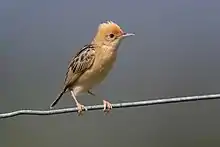
Order: Passeriformes Family: Cisticolidae
2 species recorded [2 extant native]
The Cisticolidae are warblers found mainly in warmer southern regions of the Old World. They are generally very small birds of drab brown or grey appearance found in open country such as grassland or scrub.
| Common name | Binomial | Notes |
|---|---|---|
| Zitting cisticola | Cisticola juncidis | |
| Golden-headed cisticola | Cisticola exilis |
Reed warblers and allies
Order: Passeriformes Family: Acrocephalidae
2 species recorded [1 extant native, 1 vagrant]
The members of this family are usually rather large for "warblers". Most are rather plain olivaceous brown above with much yellow to beige below. They are usually found in open woodland, reedbeds, or tall grass. The family occurs mostly in southern to western Eurasia and surroundings, but it also ranges far into the Pacific, with some species in Africa.
| Common name | Binomial | Notes |
|---|---|---|
| Oriental reed warbler | Acrocephalus orientalis | vagrant |
| Australian reed warbler | Acrocephalus australis |
Grassbirds and allies
Order: Passeriformes Family: Locustellidae
8 species recorded [5 extant native, 3 vagrant]
Locustellidae are a family of small insectivorous songbirds found mainly in Eurasia, Africa, and the Australian region. They are smallish birds with tails that are usually long and pointed, and tend to be drab brownish or buffy all over.
| Common name | Binomial | Notes |
|---|---|---|
| Spinifexbird | Poodytes carteri | |
| Little grassbird | Poodytes gramineus | |
| Brown songlark | Cincloramphus cruralis | |
| Rufous songlark | Cincloramphus mathewsi | |
| Tawny grassbird | Cincloramphus timoriensis | |
| Gray's grasshopper-warbler | Locustella fasciolata | vagrant, Ashmore Reef & possibly mainland |
| Pallas's grasshopper-warbler | Locustella certhiola | vagrant, Christmas Island & Ashmore Reef |
| Middendorff's grasshopper-warbler | Locustella ochotensis | vagrant |
Swallows
Order: Passeriformes Family: Hirundinidae
7 species recorded [6 extant native, 1 vagrant]
The family Hirundinidae is adapted to aerial feeding. They have a slender streamlined body, long pointed wings, and a short bill with a wide gape. The feet are adapted to perching rather than walking, and the front toes are partially joined at the base.
| Common name | Binomial | Notes |
|---|---|---|
| Barn swallow | Hirundo rustica | |
| Welcome swallow | Hirundo neoxena | |
| Red-rumped swallow | Cecropis daurica | |
| Fairy martin | Petrochelidon ariel | |
| Tree martin | Petrochelidon nigricans | |
| Asian house-martin | Delichon dasypus | vagrant, Christmas & Cocos (Keeling) Islands |
| White-backed swallow | Cheramoeca leucosternus |
Bulbuls
Order: Passeriformes Family: Pycnonotidae
2 species recorded [1 introduced, 1 extirpated]
Bulbuls are medium-sized songbirds. Some are colourful with yellow, red or orange vents, cheeks, throats or supercilia, but most are drab, with uniform olive-brown to black plumage. Some species have distinct crests.
| Common name | Binomial | Notes |
|---|---|---|
| Red-vented bulbul | Pycnonotus jocosus | extirpated |
| Red-whiskered bulbul | Pycnonotus jocosus | introduced |
Leaf warblers
Order: Passeriformes Family: Phylloscopidae
6 species recorded [6 vagrant]
Leaf warblers are a family of small insectivorous birds found mostly in Eurasia and ranging into Wallacea and Africa. The species are of various sizes, often green-plumaged above and yellow below, or more subdued with greyish-green to greyish-brown colours.
| Common name | Binomial | Notes |
|---|---|---|
| Yellow-browed warbler | Phylloscopus inornatus | vagrant, Ashmore Reef |
| Dusky warbler | Phylloscopus fuscatus | vagrant, Christmas Island |
| Willow warbler | Phylloscopus trochilus | vagrant, Ashmore Reef |
| Eastern crowned warbler | Phylloscopus coronatus | vagrant, Ashmore Reef |
| Arctic warbler | Phylloscopus borealis | vagrant |
| Kamchatka leaf warbler | Phylloscopus examinandus | vagrant, Ashmore Reef |
Bush warblers and allies
Order: Passeriformes Family: Scotocercidae
1 species recorded [1 vagrant]
The members of this family are found throughout Africa, Asia, and Polynesia. Their taxonomy is in flux, and some authorities place some genera in other families.[6]
| Common name | Binomial | Notes |
|---|---|---|
| Asian stubtail | Urosphena squameiceps | vagrant, Ashmore Reef |
White-eyes, yuhinas, and allies
Order: Passeriformes Family: Zosteropidae
8 species recorded [6 extant native, 1 possibly extinct native, 1 extinct native]
The white-eyes are small birds of rather drab appearance, the plumage above being typically greenish-olive, but some species have a white or bright yellow throat, breast, or lower parts, and several have buff flanks. As the name suggests, many species have a white ring around each eye.
| Common name | Binomial | Notes |
|---|---|---|
| Christmas Island white-eye | Zosterops natalis | Christmas Island |
| Lemon-bellied white-eye | Zosterops chloris | |
| Ashy-bellied white-eye | Zosterops citrinella | |
| Australian yellow white-eye | Zosterops luteus | |
| Slender-billed white-eye | Zosterops tenuirostris | Norfolk Island |
| Robust white-eye | Zosterops strenuus | extinct, Lord Howe Island |
| White-chested white-eye | Zosterops albogularis | possibly extinct, Norfolk Island |
| Silvereye | Zosterops lateralis |
Starlings
Order: Passeriformes Family: Sturnidae
8 species recorded [2 extant native, 2 introduced, 3 vagrant, 1 extinct native]
Starlings are small to medium-sized passerine birds. Their flight is strong and direct and they are very gregarious. Their preferred habitat is fairly open country. They eat insects and fruit. Plumage is typically dark with a metallic sheen.
| Common name | Binomial | Notes |
|---|---|---|
| Metallic starling | Aplonis metallica | |
| Singing starling | Aplonis cantoroides | Torres Strait |
| Norfolk starling | Aplonis fusca | extinct, Lord Howe & Norfolk Island |
| European starling | Sturnus vulgaris | introduced |
| Rosy starling | Pastor roseus | vagrant |
| Daurian starling | Agropsar sturninus | vagrant, Christmas & Cocos (Keeling) Islands |
| Chestnut-cheeked starling | Agropsar philippensis | vagrant, Ashmore Reef |
| Common myna | Acridotheres tristis | introduced |
Thrushes and allies
Order: Passeriformes Family: Turdidae
7 species recorded [3 extant native, 2 introduced, 2 vagrant]
The thrushes are a group of passerine birds that occur mainly in the Old World. They are plump, soft plumaged, small to medium-sized insectivores or sometimes omnivores, often feeding on the ground. Many have attractive songs.
| Common name | Binomial | Notes |
|---|---|---|
| Bassian thrush | Zoothera lunulata | |
| Russet-tailed thrush | Zoothera heinei | |
| Siberian thrush | Geokichla sibirica | vagrant, Ashmore Reef |
| Song thrush | Turdus philomelos | introduced |
| Eurasian blackbird | Turdus merula | introduced |
| Eye-browed thrush | Turdus obscurus | vagrant |
| Island thrush | Turdus poliocephalus | Christmas Island |
Old World flycatchers
Order: Passeriformes Family: Muscicapidae
9 species recorded [9 vagrant]
Old World flycatchers are a large group of small arboreal insectivores. The appearance of these birds is highly varied, but they mostly have weak songs and harsh calls.
| Common name | Binomial | Notes |
|---|---|---|
| Grey-streaked flycatcher | Muscicapa griseisticta | vagrant, Ashmore Reef & Cocos (Keeling) Islands |
| Dark-sided flycatcher | Muscicapa sibirica | vagrant |
| Asian brown flycatcher | Muscicapa dauurica | vagrant, Ashmore Reef, Browse & Cocos (Keeling) Islands |
| Blue-and-white flycatcher | Cyanoptila cyanomelana | vagrant |
| Siberian blue robin | Larvivora cyane | vagrant, Ashmore Reef |
| Narcissus flycatcher | Ficedula narcissina | vagrant, Ashmore Reef, Barrow Island, WA & Cocos (Keeling) Islands |
| Mugimaki flycatcher | Ficedula mugimaki | vagrant, Cocos (Keeling) Islands |
| Blue rock-thrush | Monticola solitarius | vagrant |
| Isabelline wheatear | Oenanthe isabellina | vagrant |
Flowerpeckers
Order: Passeriformes Family: Dicaeidae
2 species recorded [2 extant native]
The flowerpeckers are very small, stout, often brightly coloured birds, with short tails, short thick curved bills, and tubular tongues.
| Common name | Binomial | Notes |
|---|---|---|
| Red-capped flowerpecker | Dicaeum geelvinkianum | Torres Strait |
| Mistletoebird | Dicaeum hirundinaceum |
Sunbirds and spiderhunters
Order: Passeriformes Family: Nectariniidae
1 species recorded [1 extant native]
The sunbirds and spiderhunters are very small passerine birds which feed largely on nectar, although they will also take insects, especially when feeding young. Their flight is fast and direct on short wings. Most species can take nectar by hovering like a hummingbird, but usually perch to feed.
| Common name | Binomial | Notes |
|---|---|---|
| Olive-backed sunbird | Nectarinia jugularis |
Waxbills and allies
Order: Passeriformes Family: Estrildidae
22 species recorded [18 extant native, 3 introduced, 1 vagrant]
The estrildid finches are small passerine birds of the Old World tropics and Australasia. They are gregarious and often colonial seed eaters with short thick but pointed bills. They are all similar in structure and habits, but have wide variation in plumage colours and patterns.
| Common name | Binomial | Notes |
|---|---|---|
| Painted firetail | Emblema pictum | |
| Beautiful firetail | Stagonopleura bella | |
| Red-eared firetail | Stagonopleura oculata | |
| Diamond firetail | Stagonopleura guttata | |
| Red-browed finch | Neochmia temporalis | |
| Crimson finch | Neochmia phaeton | |
| Star finch | Neochmia ruficauda | |
| Plum-headed finch | Neochmia modesta | |
| Zebra finch | Taeniopygia guttata | |
| Double-barred finch | Taeniopygia bichenovii | |
| Masked finch | Poephila personata | |
| Long-tailed finch | Poephila acuticauda | |
| Black-throated finch | Poephila cincta | |
| Blue-faced parrotfinch | Erythrura trichroa | |
| Gouldian finch | Erythrura gouldiae | |
| Scaly-breasted munia | Lonchura punctulata | introduced, mainland; vagrant, Ashmore Reef |
| Chestnut munia | Lonchura atricapilla | introduced |
| Pale-headed munia | Lonchura pallida | vagrant, Ashmore Reef |
| Yellow-rumped munia | Lonchura flaviprymna | |
| Chestnut-breasted munia | Lonchura castaneothorax | |
| Java sparrow | Lonchura oryzivora | introduced, Christmas Island |
| Pictorella munia | Heteromunia pectoralis |
Old World sparrows
Order: Passeriformes Family: Passeridae
2 species recorded [2 introduced]
Old World sparrows are small passerine birds, typically small, plump, brown or grey with short tails and short powerful beaks. They are seed-eaters, but also consume small insects.
| Common name | Binomial | Notes |
|---|---|---|
| House sparrow | Passer domesticus | introduced |
| Eurasian tree sparrow | Passer montanus | introduced |
Wagtails and pipits
Order: Passeriformes Family: Motacillidae
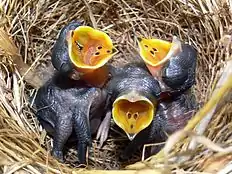
10 species recorded [4 extant native, 6 vagrant]
Motacillidae is a family of small passerine birds with medium to long tails and comprises the wagtails, longclaws, and pipits. These are slender ground-feeding insectivores of open country.
| Common name | Binomial | Notes |
|---|---|---|
| Forest wagtail | Dendronanthus indicus | vagrant |
| Grey wagtail | Motacilla cinerea | vagrant |
| Western yellow wagtail | Motacilla flava | |
| Eastern yellow wagtail | Motacilla tschutschensis | |
| Citrine wagtail | Motacilla citreola | vagrant |
| White wagtail | Motacilla alba | vagrant |
| Australasian pipit | Anthus novaeseelandiae | |
| Paddyfield pipit | Anthus rufulus | |
| Pechora pipit | Anthus gustavi | vagrant, Ashmore Reef & Browse Island |
| Red-throated pipit | Anthus cervinus | vagrant |
Finches, euphonias, and allies
Order: Passeriformes Family: Fringillidae
5 species recorded [4 introduced, 1 introduced vagrant]
Finches are small to moderately large seed-eating passerine birds with a strong beak, usually conical and in some species very large. All have 12 tail feathers and nine primary flight feathers. Finches have a bouncing flight, alternating bouts of flapping with gliding on closed wings, and most sing well.
| Common name | Binomial | Notes |
|---|---|---|
| Common chaffinch | Fringilla coelebs | vagrant from introduced NZ population, Macquarie, Lord Howe & Norfolk Island |
| European greenfinch | Chloris chloris | introduced |
| Common redpoll | Acanthis flammea | introduced, Macquarie Island & vagrant, Lord Howe Island; in both cases, from introduced NZ population |
| Lesser redpoll | Acanthis cabaret | introduced |
| European goldfinch | Carduelis carduelis | introduced |
Old World buntings
Order: Passeriformes Family: Emberizidae
1 species recorded [1 introduced vagrant]
The emberizids are a large family of seed-eating birds with distinctively shaped bills. Many emberizid species have distinctive head patterns.
| Common name | Binomial | Notes |
|---|---|---|
| Yellowhammer | Emberiza citrinella | vagrant from introduced NZ population, Lord Howe Island & possibly Macquarie Island |
See also
References
- Christidis, Leslie; Boles, Walter (2008). Systematics and Taxonomy of Australian Birds. Melbourne: CSIRO. ISBN 978-0-643-09602-8.
- Christidis, Leslie; Boles, Walter (1994). The Taxonomy and Species of Birds of Australia and its Territories. Royal Australasian Ornithologists Union. ISBN 978-1-875122-06-6.
- "Birds Australia Checklist". Birds Australia. Archived from the original on 2010-01-07. Retrieved 2010-01-04.
- Lepage, Denis. "Checklist of birds of Australia". Bird Checklists of the World. Avibase. Retrieved 13 October 2019.
- "Birds of Western Australia, the complete checklist". WICE (World Institute for Conservation and Environment). Retrieved 13 October 2019.
- Gill, F. and D. Donsker (Eds). 2019. IOC World Bird List (v 9.2). Doi 10.14344/IOC.ML.9.2. http://www.worldbirdnames.org/ retrieved 22 June 2019


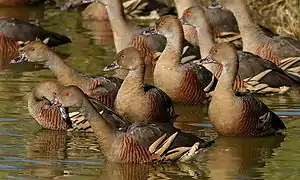
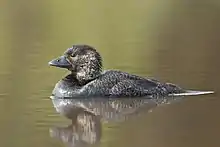
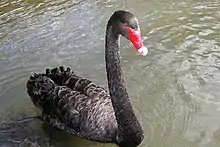

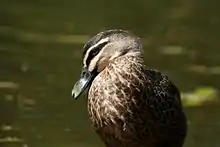


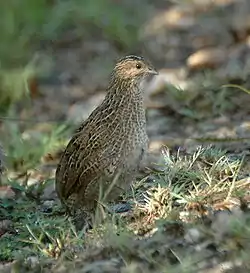
.jpg.webp)
